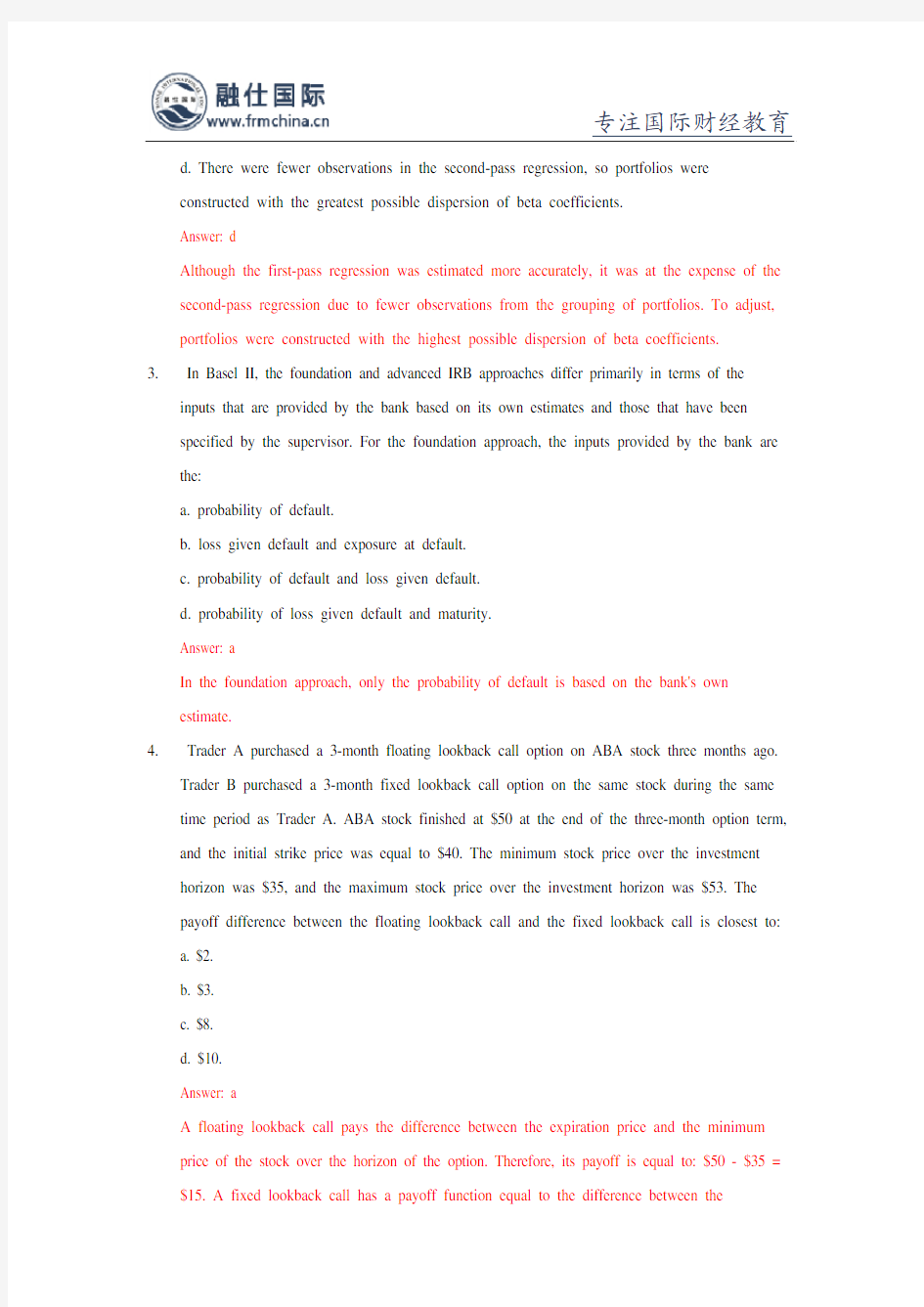FRM二级模拟题(二)


FRM二级模拟题(二)
1. Kate Harrison, FRM, is the risk manager for a medium-sized, regional depository institution
with significant concentration risk in outstanding loans. She is trying to estimate and hedge the banks' exposure to credit losses. First, Kate has decided to estimate credit VaR using
CreditPortfolio View because of its use of macroeconomic transition matrices. She decided not to use the CreditRisk+ approach because of its reliance on non-parametric methods.
Lastly, she is concerned that the proposed hedge bears counterparty risk and proposes a
vulnerable option calculation to evaluate this risk. Which of Kate's conclusions are accurate?
a. Her statement about CreditPortfolioView and CreditRisk+ are correct, but her statement
about vulnerable options is not.
b. Her statement about CreditPortfolioView is correct, but her statements about CreditRisk+
and vulnerable options are not.
c. Her statement about CreditRisk+ and vulnerable options are correct, but her statement
about CreditPortfolio View is not.
d. Her statements about CreditPortfolioView and vulnerable options are correct, but her
statement about CreditRisk十 is not.
Answer: d
Vulnerable options are options with positive probability of default. CreditRisk + assumes a specific functional Form and does not use non-parametric methods. CreditPortfolio View incorporates macroeconomic transition matrices since macro factors are the principal drivers of default.
2. In determining thar prior capital asset pricing model (CAPM) tests of validity were flawed,
Richard Roll and other researchers tried to correct for flawed security market line (SML) estimates by using portfolios rather than individual securities. How would the results of their first-pass and second-pass regression estimates be best described when the portfolio approach was used?
a. The first-pass regression and second-pass regression were equally accurate.
b. The second-pass regression was more accurate, improved by the portfolio approach.
c. There were more observations in the second-pass regression, so portfolios were
constructed with the smallest possible dispersion of beta coefficients.
d. There were fewer observations in the second-pass regression, so portfolios were
constructed with the greatest possible dispersion of beta coefficients.
Answer: d
Although the first-pass regression was estimated more accurately, it was at the expense of the second-pass regression due to fewer observations from the grouping of portfolios. To adjust, portfolios were constructed with the highest possible dispersion of beta coefficients.
3. In Basel II, the foundation and advanced IRB approaches differ primarily in terms of the
inputs that are provided by the bank based on its own estimates and those that have been
specified by the supervisor. For the foundation approach, the inputs provided by the bank are the:
a. probability of default.
b. loss given default and exposure at default.
c. probability of default and loss given default.
d. probability of loss given default and maturity.
Answer: a
In the foundation approach, only the probability of default is based on the bank's own
estimate.
4. Trader A purchased a 3-month floating lookback call option on ABA stock three months ago.
Trader B purchased a 3-month fixed lookback call option on the same stock during the same time period as Trader A. ABA stock finished at $50 at the end of the three-month option term, and the initial strike price was equal to $40. The minimum stock price over the investment horizon was $35, and the maximum stock price over the investment horizon was $53. The payoff difference between the floating lookback call and the fixed lookback call is closest to:
a. $2.
b. $3.
c. $8.
d. $10.
Answer: a
A floating lookback call pays the difference between the expiration price and the minimum
price of the stock over the horizon of the option. Therefore, its payoff is equal to: $50 - $35 = $15. A fixed lookback call has a payoff function equal to the difference between the
maximum price during the option's life and the strike price. Therefore, its payoff is equal to: $53 - $40 = $13. The payoff difference between the two exotic options is equal to $2.
5. An analyst has the following .information pertaining to Portfolio x:
. Risk-free rate = 2%.
. Actual portfolio return = 10% .
. Relevant benchmark return - 8%.
. Portfolio standard deviarion = 5%.
. Observed tracking error = 3%.
Which of the following statements regarding Portfolio X is correct?
a. The information ratio is 0.67.
b. The information ratio is l.60.
c. The Sharpe ratio is 0.40.
d. The Sharpe ratio is 2.67.
Answer: a
The information ratio is calculated as: (10% - 8%) / 3% = 0.67
The Sharpe ratio is calculated as: (l0% - 2%) / 5% = 1.60
